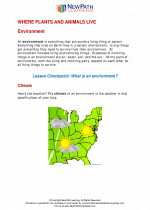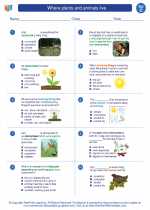Where Plants and Animals Live
Plants and animals live in different habitats that provide the necessary resources for their survival. A habitat is the natural environment where an organism lives, and it includes both biotic (living) and abiotic (non-living) factors. Understanding the different types of habitats can help us learn more about the diverse ecosystems on Earth.
Types of Habitats
1. Terrestrial Habitats
Terrestrial habitats refer to the land-based habitats where both plants and animals live. These habitats can include forests, grasslands, deserts, and tundras. Each type of terrestrial habitat has its own unique characteristics and supports specific plant and animal species.
2. Aquatic Habitats
Aquatic habitats are the habitats found in water bodies such as oceans, rivers, lakes, and ponds. These habitats are home to a wide variety of aquatic plants and animals, including fish, amphibians, and aquatic insects. The different water bodies have their own distinct features and support diverse forms of life.
Adaptations to Habitats
Plants and animals have evolved various adaptations to survive in their specific habitats. These adaptations can include physical features, behaviors, and life cycles that allow them to thrive in their environment. For example, cacti have adapted to the dry desert environment by storing water in their stems, while polar bears have thick fur and a layer of fat to survive in the cold Arctic habitat.
Importance of Habitats
Habitats are crucial for the survival of plants and animals as they provide food, water, shelter, and breeding grounds. Human activities such as deforestation, pollution, and habitat destruction can have detrimental effects on these ecosystems, leading to the loss of biodiversity and threatening the survival of many species.
Study Guide
- What is a habitat?
- Give examples of terrestrial habitats.
- Describe adaptations that animals have for living in their habitats.
- Explain the importance of preserving habitats for plants and animals.
Understanding where plants and animals live helps us appreciate the interconnectedness of life on Earth and the importance of preserving diverse habitats for the well-being of all living organisms.
.◂Science Worksheets and Study Guides Third Grade. Where plants and animals live

 Worksheet/Answer key
Worksheet/Answer key
 Worksheet/Answer key
Worksheet/Answer key
 Worksheet/Answer key
Worksheet/Answer key
 Vocabulary/Answer key
Vocabulary/Answer key
 Vocabulary/Answer key
Vocabulary/Answer key
